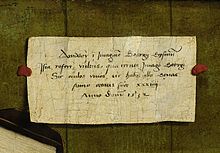Cartellino

A cartellino ( ital. Cartellino (m.), Plural cartellini ; 'small piece of paper, label, label'; German the cartellino or - more often - the cartellino) is a term from painting and originated in the Italian painting of the Renaissance . It is a small banner realistically drawn into a painting, a piece of a scroll or a small piece of paper with legible inscription.
It is usually in the foreground on a parapet or on a frame drawn in the manner of a trompe-l'œil , or in the background, for example on a wall. A cartellino is used to carry the artist's signature - with or without the year - (as e.g. in the works of Giovanni Bellini , Benedetto Diana or Antonello da Messina ), or it can convey a religious or philosophical motto to the viewer , that is related to the depicted scene or persons depicted.
According to Rawlings, the first Cartellino can be found in the painting Tarquinia Madonna by Fra Filippo Lippi from 1437. The use of Cartellini in Italian painting increased from the middle of the 15th century until it was used in the first quarter of the 16th century Peaked in popularity.
Cartellino hidden in the grass ( Carpaccio , 1510)
Individual evidence
literature
- Irene Earls Renaissance Art: A Topical Dictionary , ABC-CLIO (1987), S. 54 (Engl.)
- Kandice Rawlings: Liminal Messages: The Cartellino in Italian Renaissance Painting , Dissertation (2009)






